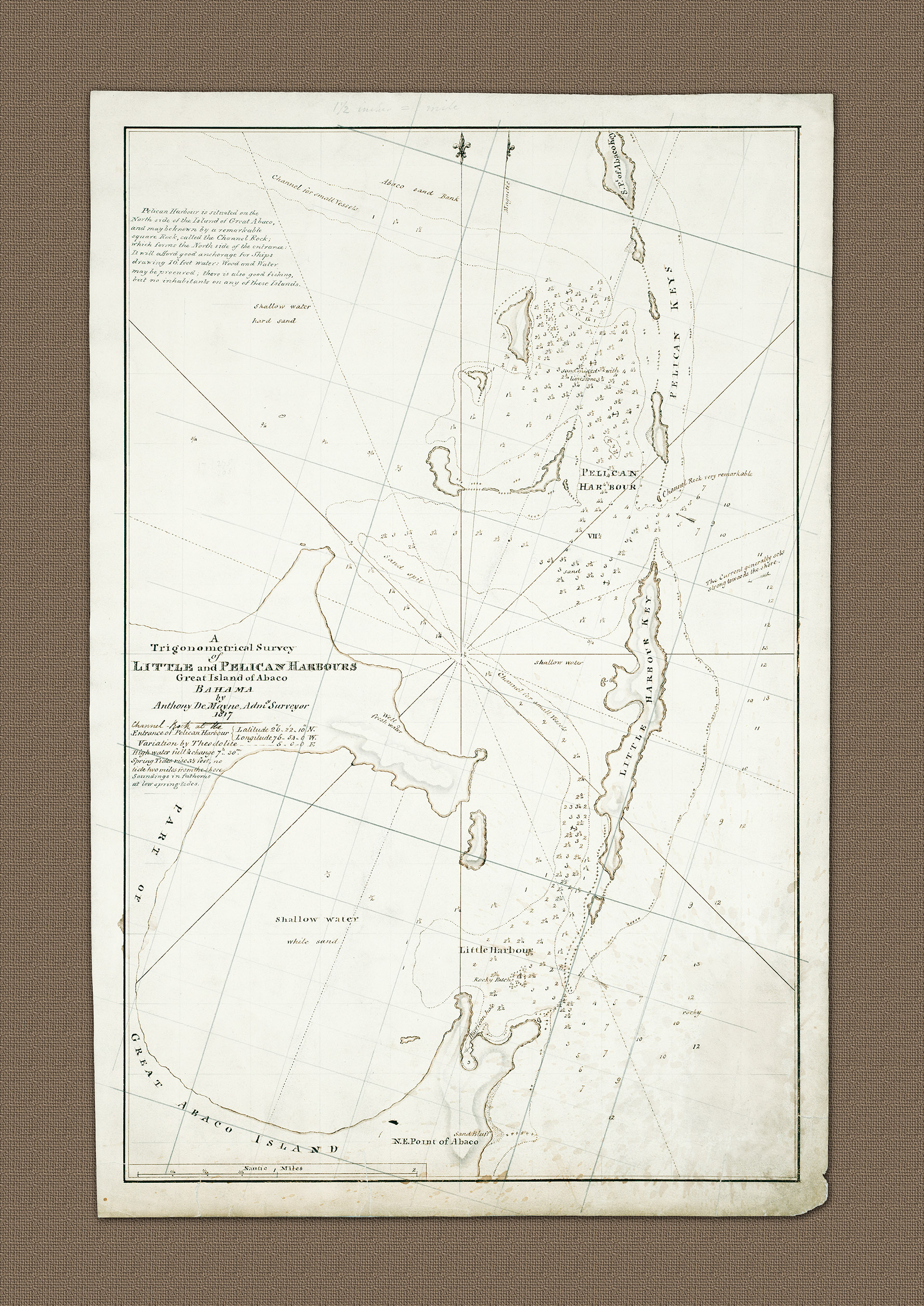A727 - Little and Pelican Harbours, Great Island of Abaco, Bahamas
- 1817
- Anthony De Mayne
- h22.5" x w16"
- P
Perhaps the single most obvious aspect of this survey are the names given to the Islands at the time of surveying. Little Harbour Key is now of course Lynyard Cay and the islands which surround Pelican Harbour on De Mayne's survey are now called Sandy, Cornish and Channel Cays.
Much is made by De Mayne of the island or a remarkable square rock called Channel Rock just to the North of Little Harbour Key (Lynyard Cay) which marks the entrance into what was then Pelican Harbour as defined by the ring of cays. He gives the landmark a Latitude of 26°, 22", 10" and a Longitude of 76°, 54". Out of interest and with the benefit of modern satellite technology the rock is in fact at 26°, 39", and 76°, 97".
Tempting as it may be to test De Mayne's skill as a surveyor by sailing and navigating by his survey, Heritage Charts accepts no responsibility for such actions and advises against such activity.
De Mayne goes on to state that fresh water and wood may be procured from these small islands, although none of them were inhabited. The overall style De Mayne employed in producing this survey is the same as his other surveys in the Heritage Charts collection. He uses soft greens and browns to highlight the islands and cays. He also uses standard Admiralty symbols for rocks, shoals, sand-banks and tides. His attention to detail with the soundings is more than enough to engender confidence amongst sailors, of the time, in the accuracy of the survey.
Not until after the American Revolutionary War had finally ended in 1783 did the Bahamas and the outer islands of the Abaco take-on a noticeable, if not significant, role in history: With the expulsion of Loyalist sympathizers from their colonial holdings in 1782 the British government, which in itself had only until November 1783 to vacate the city of New York, it's last holding in America, struggled to find refuge for it's vanquished and now penniless supporters.
England apart, Canada was one option, the Abaco islands was the other. The first ship full of emigres had left New York in August 1783 for a land which British surveyor John Wilson described as being '..one fifth part of the face of the country is nothing but rock'. He went on to describe the suitability of whatever soil there was as being suitable only for; cotton, vegetables & guinea corn. As an estimation of sustainability Wilson's survey proved to be optimistic in as much as it would take a higher level of expertise and land management to fulfil the promises beyond the hopes of both the emigres and the British government, which frankly didn't exist.
By the 1790s civil unrest was boiling over, especially amongst the races. Initially, it seems, indenture had been implemented forcing even free blacks to 'belong' to whites. Many of the former slaves who had 'emigrated' complained that they thought, under British law that they would be free. With shortages of all kinds social order was further under threat. Agriculture had failed due to inefficient land management, cotton never developed as hoped on Abaco, although it had on the southern islands of Eleuthera.
When the provisions supplied by the British government had run out, starvation had taken hold for many. Many of the original Loyalist immigrants had moved away to Nassau or beyond. Only fledgling settlements and communities survived. A second immigration of people, this time from the more southerly Eluethera Islands, brought expertise in boat building, fishing and wrecking and these three industries in particular proved the way forward for many with towns such as New Plymouth on Green Turtle Cay and Hope Town on Elbow Cay springing-up and developing as a direct result of these industries.
References: 'Abaco: The History of an Out Island and its Cays'. Steve Dodge, Professor of History, Millikin University, Third Edition (2005). White Sound Press.
- Little and Pelican Harbours, Great Island of Abaco, Bahamas


